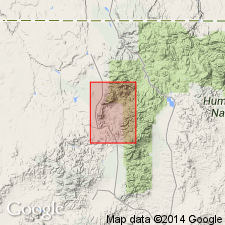
- Usage in publication:
-
- Porter Peak Limestone
- Modifications:
-
- Named
- Dominant lithology:
-
- Limestone
- AAPG geologic province:
-
- Great Basin province
Summary:
Pg. 15-17, 36 (table 1), pI. 1. Porter Peak Limestone. Upper two-thirds of massive blue-gray limestone; lower third contains 0.5- to 2-inch black and tan bands of dolomitic limestone and two intraformation limestone conglomerate layers. Thickness about 3,200 feet. Overlies Edgemont Formation (new); underlies Aura Formation (new), both contacts conformable. Age is Late Cambrian or Early Ordovician, based on fossils (identified by H.J. Johnson and W.A. Stewart, Colorado School of Mines) collected from lower part of unit. [Age is Cambrian on map legend.]
Type locality not designated. Named from Porter Peak in northern part of Bull Run 15-min quadrangle, Elko Co., northeastern NV. Two of the three summits of Porter Peak are developed on the limestone. Exposed in wide band crossing range in east-west direction north of Bull Run Creek, in downfaulted block immediately south of Bull Run Canyon, and to extreme south in portion of range known as Lime Mountain.
Source: US geologic names lexicon (USGS Bull. 1350, p. 593); GNU records (USGS DDS-6; Menlo GNULEX).
For more information, please contact Nancy Stamm, Geologic Names Committee Secretary.
Asterisk (*) indicates published by U.S. Geological Survey authors.
"No current usage" (†) implies that a name has been abandoned or has fallen into disuse. Former usage and, if known, replacement name given in parentheses ( ).
Slash (/) indicates name conflicts with nomenclatural guidelines (CSN, 1933; ACSN, 1961, 1970; NACSN, 1983, 2005, 2021). May be explained within brackets ([ ]).

